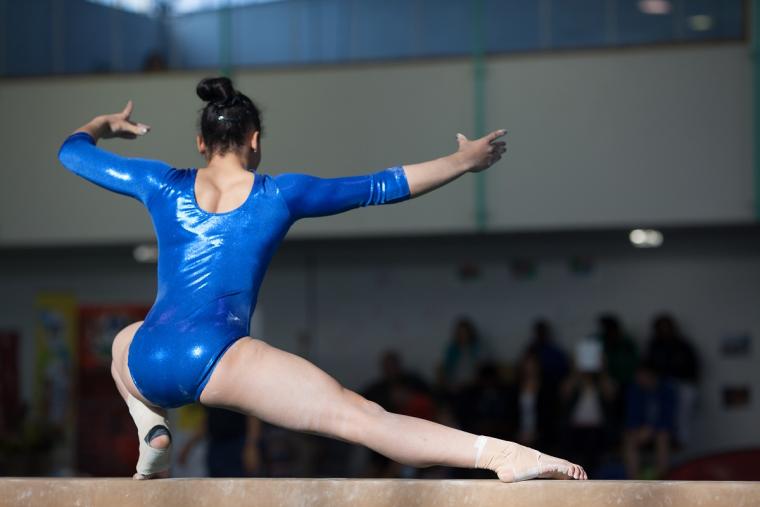
Tulsa’s BOK Center and Cox Business Center will welcome more than 1,600 of the nation’s top acrobatic, rhythmic, and trampoline and tumbling gymnasts and hundreds of coaches, judges and support staff June 20-24 for the 2023 USA Gymnastics Championships. The annual event determines national champions across the developmental and elite levels for each represented discipline and attracts Olympians and World medalists in addition to the country’s most-promising up-and-coming athletes.
“The USA Gymnastics Championships mark the culmination of the domestic season for three separate disciplines, creating a high-energy environment featuring some of the best gymnasts in the world,” said Stefanie Korepin, USA Gymnastics Chief Programs Officer. “Tulsa previously hosted the 2000 U.S. Classic, and we’re excited to return with an event of this caliber and scope. We know our athletes and fans will be welcomed warmly.”
U.S. Junior and Senior National Teams for each discipline will be named following the conclusion of competition, and performances will inform selection for international assignments, including fall World Championships.
“It is an honor to have been selected as host city for the prestigious 2023 USA Gymnastics Championships,” said Tulsa’s Deputy Mayor Cassia Carr. “For five days, Tulsa will host 2,200 event attendees that will have an estimated $3,361,321 impact on our city’s economy. This is certainly something to celebrate as we gear up to welcome these world-class athletes to Tulsa in June.”
The USA Gymnastics Championships were first held as a combined national championship event in 2014. Competitors in 2022 included, among others, 2020 Olympians in rhythmic gymnastics Evita Griskenas (Orland Park, Ill./North Shore Rhythmic Gymnastics Center) and Lili Mizuno (Northbrook, Ill./North Shore Rhythmic Gymnastics Center), reigning acro World champions in men’s pair Angel Felix (Moreno Valley, Calif./Realis Gymnastics Academy) and Braiden McDougall (Riverside, Calif./Realis Gymnastics Academy), The World Games men’s tumbling champion Kaden Brown (Herriman, Utah/Wasatch Trampoline & Tumbling) and women’s tumbling silver medalist Miah Bruns (Crete, Ill./World Champions Centre), two-time Olympian in women’s trampoline Nicole Ahsinger (Lafayette, La./Trampoline and Tumbling Express), and World double-mini individual silver medalists Shelby Nobuhara (Mapleton, Utah/High Altitude) and Ruben Padilla (Bluffdale, Utah/Wasatch Trampoline & Tumbling).
“The 2023 USA Gymnastics Championships are going to be an incredible five days for Tulsa,” said Renee McKenney, Senior Vice President of the Tulsa Regional Chamber and President of Tulsa Regional Tourism. “With an estimated 4,133 hotel rooms that will be booked for this five-day event, downtown Tulsa is going to be full of visitors – many in town for their first time. We can’t wait to host these talented gymnasts and their families and friends to Tulsa this summer.”
For more information on the USA Gymnastics Championships, please visit usagymchamps.com.
About acrobatic, rhythmic, and trampoline and tumbling gymnastics
Acrobatic gymnastics combines the beauty of dance with the strength and agility of acrobatics. Routines are choreographed to music and consist of dance, tumbling, and partner skills. At the elite level, each pair or group performs a balance, dynamic and combined routine. Pyramids and partner holds form the foundation of the balance routine, while synchronized tumbling and intricate flight elements define the dynamic exercise. An acrobatic gymnastics pair consists of a base and a top. A women's group is comprised of three athletes, assuming the base, middle and top positions, and a men's group has four athletes – a single base and top and two gymnasts occupying the middle position.
Rhythmic gymnastics is characterized by grace and elegance combined with dance and acrobatic elements, while working with apparatus in a choreographed routine set to music. The five apparatus used in rhythmic gymnastics are rope, hoop, ball, clubs, and ribbon. Rhythmic gymnasts may compete individually or as a group. The choreography must cover the entire floor with intricate apparatus handling, dance combinations, jumps, leaps, rotations and balance difficulties. Each movement involves a high degree of athletic skill, and competitors draw on strength, power, flexibility, agility, dexterity, endurance and hand-eye coordination. The rhythmic gymnastics individual all-around competition was added to the Olympic program in 1984 with group competition following in 1996.
Trampoline events use large trampolines to propel gymnasts up to 30 feet in the air where they perform twists and somersaults. Tumbling utilizes elevated rod-floor runways that enable athletes to jump to heights of more than 10 feet and execute a variety of acrobatic maneuvers. In double mini trampoline, athletes make a short run, leap onto a small two-level trampoline, perform a two-jump pass comprised of various aerial skills and dismount onto a landing mat. Individual men’s and women’s trampoline was added to the Olympic Games in 2000.

There are no comments
Please login to post comments